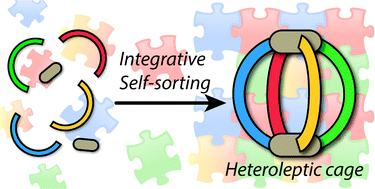当前位置:
X-MOL 学术
›
Chem. Commun.
›
论文详情
Our official English website, www.x-mol.net, welcomes your
feedback! (Note: you will need to create a separate account there.)
Integrative self-sorting of coordination cages based on ‘naked’ metal ions
Chemical Communications ( IF 4.3 ) Pub Date : 2017-06-29 00:00:00 , DOI: 10.1039/c7cc03379f Witold M. Bloch 1, 2, 3, 4 , Guido H. Clever 1, 2, 3, 4
Chemical Communications ( IF 4.3 ) Pub Date : 2017-06-29 00:00:00 , DOI: 10.1039/c7cc03379f Witold M. Bloch 1, 2, 3, 4 , Guido H. Clever 1, 2, 3, 4
Affiliation

|
Coordination-driven self-assembly of metal ions and organic ligands has been extensively utilised over the past four decades to access a variety of nano-sized cage assemblies, with functions ranging from sensing and catalysis to drug delivery. Many of the reported examples, however, are highly symmetric architectures that contain one type of organic ligand carrying not more than a single functionality. This contrasts significantly with the level of structural and functional complexity encountered in biological macromolecular hosts, which are able to bind and chemically convert smaller molecules in their highly-decorated internal cavities. To address this disparity, rational approaches that facilitate heteroleptic assembly by regulating integrative self-sorting of metal ions and multiple ligand components have emerged. Among these, routes to access coordination cages from ‘naked’ metal cations that offer more than two coordination sites are still in early development, as the complexity of the self-sorted products in terms of composition and stereochemistry presents an entropic challenge. This feature article highlights recent progress in controlling integrative self-sorting of multi-component cage systems with a focus on structures composed of ‘naked’ metal cations and two different ligands. Once heteroleptic self-assembly strategies find a wider implementation in supramolecular design, the resultant interplay between tailored combinations of precisely positioned substituents promises enhanced functionality in nanoscale structures.
中文翻译:

基于“裸”金属离子的协调笼的综合自选
在过去的四十年中,金属离子和有机配体的配位驱动的自组装已被广泛使用,以访问各种纳米尺寸的笼组件,其功能范围从传感和催化到药物递送。然而,许多报道的实例是高度对称的结构,其包含一种类型的有机配体,其携带的官能团不超过一个。这与生物大分子宿主遇到的结构和功能复杂性水平形成鲜明对比,生物大分子宿主能够在高度装饰的内腔中结合并化学转化较小的分子。为了解决这种差异,已经出现了通过调节金属离子和多个配体组分的整体自选来促进杂配子组装的合理方法。在这些当中,从提供两个以上配位点的“裸”金属阳离子进入配位笼的途径仍处于早期开发阶段,因为自选产物在组成和立体化学方面的复杂性给熵带来了挑战。这篇专题文章重点介绍了在控制多组分笼式系统的整体自选中的最新进展,重点是由“裸”金属阳离子和两种不同配体组成的结构。一旦杂化剂自组装策略在超分子设计中得到更广泛的应用,精确定位的取代基的量身定制组合之间的相互作用将保证纳米级结构的功能性增强。由于自分类产品在组成和立体化学方面的复杂性提出了熵挑战。这篇专题文章重点介绍了在控制多组分笼式系统的整体自选中的最新进展,重点是由“裸”金属阳离子和两种不同配体组成的结构。一旦杂化剂自组装策略在超分子设计中得到更广泛的应用,精确定位的取代基的量身定制组合之间的相互作用将保证纳米级结构的功能性增强。由于自分类产品在组成和立体化学方面的复杂性提出了熵挑战。这篇专题文章重点介绍了在控制多组分笼式系统的整体自选中的最新进展,重点是由“裸”金属阳离子和两种不同配体组成的结构。一旦杂化剂自组装策略在超分子设计中得到更广泛的应用,精确定位的取代基的量身定制组合之间的相互作用将保证纳米级结构的功能性增强。这篇专题文章重点介绍了在控制多组分笼式系统的整体自选中的最新进展,重点是由“裸”金属阳离子和两种不同配体组成的结构。一旦杂化剂自组装策略在超分子设计中得到更广泛的应用,精确定位的取代基的量身定制组合之间的相互作用将保证纳米级结构的功能性增强。这篇专题文章重点介绍了在控制多组分笼式系统的整体自选中的最新进展,重点是由“裸”金属阳离子和两种不同配体组成的结构。一旦杂化剂自组装策略在超分子设计中得到更广泛的应用,精确定位的取代基的量身定制组合之间的相互作用将保证纳米级结构的功能性增强。
更新日期:2017-07-28
中文翻译:

基于“裸”金属离子的协调笼的综合自选
在过去的四十年中,金属离子和有机配体的配位驱动的自组装已被广泛使用,以访问各种纳米尺寸的笼组件,其功能范围从传感和催化到药物递送。然而,许多报道的实例是高度对称的结构,其包含一种类型的有机配体,其携带的官能团不超过一个。这与生物大分子宿主遇到的结构和功能复杂性水平形成鲜明对比,生物大分子宿主能够在高度装饰的内腔中结合并化学转化较小的分子。为了解决这种差异,已经出现了通过调节金属离子和多个配体组分的整体自选来促进杂配子组装的合理方法。在这些当中,从提供两个以上配位点的“裸”金属阳离子进入配位笼的途径仍处于早期开发阶段,因为自选产物在组成和立体化学方面的复杂性给熵带来了挑战。这篇专题文章重点介绍了在控制多组分笼式系统的整体自选中的最新进展,重点是由“裸”金属阳离子和两种不同配体组成的结构。一旦杂化剂自组装策略在超分子设计中得到更广泛的应用,精确定位的取代基的量身定制组合之间的相互作用将保证纳米级结构的功能性增强。由于自分类产品在组成和立体化学方面的复杂性提出了熵挑战。这篇专题文章重点介绍了在控制多组分笼式系统的整体自选中的最新进展,重点是由“裸”金属阳离子和两种不同配体组成的结构。一旦杂化剂自组装策略在超分子设计中得到更广泛的应用,精确定位的取代基的量身定制组合之间的相互作用将保证纳米级结构的功能性增强。由于自分类产品在组成和立体化学方面的复杂性提出了熵挑战。这篇专题文章重点介绍了在控制多组分笼式系统的整体自选中的最新进展,重点是由“裸”金属阳离子和两种不同配体组成的结构。一旦杂化剂自组装策略在超分子设计中得到更广泛的应用,精确定位的取代基的量身定制组合之间的相互作用将保证纳米级结构的功能性增强。这篇专题文章重点介绍了在控制多组分笼式系统的整体自选中的最新进展,重点是由“裸”金属阳离子和两种不同配体组成的结构。一旦杂化剂自组装策略在超分子设计中得到更广泛的应用,精确定位的取代基的量身定制组合之间的相互作用将保证纳米级结构的功能性增强。这篇专题文章重点介绍了在控制多组分笼式系统的整体自选中的最新进展,重点是由“裸”金属阳离子和两种不同配体组成的结构。一旦杂化剂自组装策略在超分子设计中得到更广泛的应用,精确定位的取代基的量身定制组合之间的相互作用将保证纳米级结构的功能性增强。











































 京公网安备 11010802027423号
京公网安备 11010802027423号